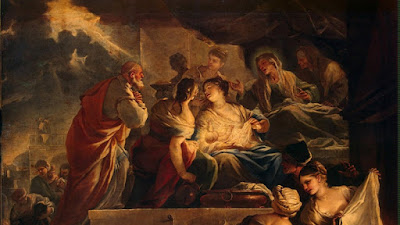Birth of St. John the Baptist: Giordano Luca (1670's), The Hermitage
Among the casualties of liturgical change and relaxation in discipline in the past few centuries has been the loss of importance for the Feast of the Nativity of St. John the Baptist on June 24th. In "Christian Feasts and Customs," Father Weiser writes of the importance of the Feast of St. John's Nativity:
"The Council of Agde, in 506, listed the Nativity of Saint John among the highest feasts of the year, a day on which all faithful had to attend Mass and abstain from servile work. Indeed, so great was the rank of this festival that, just as on Christmas, three Masses were celebrated, one during the vigil service, the second at dawn, the third in the morning. In 1022, a synod at Seligenstadt, Germany, prescribed a fourteen-day fast and abstinence in preparation for the Feast of the Baptist. This, however, was never accepted into universal practice by the Roman authorities."By the time of the changes to the Holy Days of Obligation in 1642, Pope Urban VIII kept the Nativity of St. John the Baptist as a day of precept. Why the importance? Father Wiser explains:
"The days of all the Apostles were raised to the rank of public holydays in 932. The feasts of Saint Michael, Saint Stephen, Saint John the Baptist, and other saints of the early centuries were celebrated in the past as holydays among all Christian nations."By the time of his writing in the 1950s, in regards to the feasts of saints (i.e., not Feasts of our Lord), only St. Joseph, Ss. Peter and Paul, All Saints, and the Marian feasts of the Assumption and the Immaculate Conception remained as days of precept. And of these, Saint Joseph and Ss. Peter and Paul were exempt from obligation in the United States as they had been previously abrogated.
In Ireland, the Nativity of St. John the Baptist remained as a day of full precept longer than many other days. When changes were made to the Irish holydays in 1755 under Pope Benedict XIV and in 1778 under Pope Pius VI, the Nativity of St. John remained as a day of double precept, even when the feasts of the apostles were reduced to single precept. It was not abolished as a day of precept until 1831 in Ireland
The southeastern Colonies in modern-day Florida and Lousiana kept the Vigil of the Nativity of St. John the Baptist as a day of fasting for much longer than other places. Even today, the Vigil of the Nativity of St. John the Baptist is celebrated with bonfires in many Catholic nations. And St. John the Baptist's Nativity is a public holiday in Quebec and Puerto Rico and Catalonia (where Barcelona is).
The Nativity of St. John the Baptist is one of only three birthdays celebrated by the Church - the other two are of our Lord and our Lady. The uniqueness of the Nativity of St. John and its previous rank as one of the primary holydays should instill in us greater devotion to this festival day, and a greater desire to do penance in advance.
Dom Gueranger, writing on the great Feast of the Nativity of the Lord's Forerunner, relates the following:
On this day, therefore, let us too imitate the Church; let us avoid that forgetfulness which bespeaks ingratitude; let us hail, with thanksgiving and heartfelt gladness, the arrival of him who promises our Saviour to us. Already Christmas is announced. On the Lateran Piazza (or Square) the faithful Roman people will keep vigil to-night, awaiting the hour which will allow the eve's strict fast and abstinence to be broken, when they may give themselves up to innocent enjoyment, the prelude of those rejoicings wherewith, six months hence, they will be greeting the Emmanuel.
St John's vigil is no longer of precept. Formerly, however, not one day’s fasting only, but an entire Lent was observed at the approach of the Nativity of the Precursor, resembling in its length and severity that of the Advent of our Lord. The more severe had been the holy exactions of the preparation, the more prized and the better appreciated would be the festival. After seeing the penance of St John's fast equalled to the austerity of that preceding Christmas, is it not surprising to behold the Church in her liturgy making the two Nativities closely resemble one another, to a degree that would be apt to stagger the limping faith of many nowadays?
The Nativity of St John, like that of our Lord, was celebrated by three Masses: the first, in the dead of night, commemorated his title of Precursor; the second, at daybreak, honoured the baptism he conferred; the third, at the hour of Terce, hailed his sanctity. The preparation of the bride, the consecration of the Bridegroom, his own peerless holiness: a threefold triumph, which at once linked the servant to the Master, and deserved the homage of a triple sacrifice to God the Thrice-Holy, manifested to John in the plurality of his Persons, and revealed by him to the Church. In like manner, as there were formerly two Matins on Christmas night, so, in many places, a double Office was celebrated on the feast of St John, as Durandus of Mende, following Honorius of Autun, informs us. The first Office began at the decline of day; it was without Alleluia, in order to signify the time of the Law and the Prophets which lasted up to St John. The second Office, begun in the middle of the night, terminated at dawn; this was sung with Alleluia, to denote the opening of the time of grace and of the kingdom of God.Collect:
O God, Who hast made this day worthy of honor by the birth of blessed John: grant to Thy people the grace of spiritual joys, and direct the minds of all the faithful into the way of eternal salvation. Through our Lord.

















